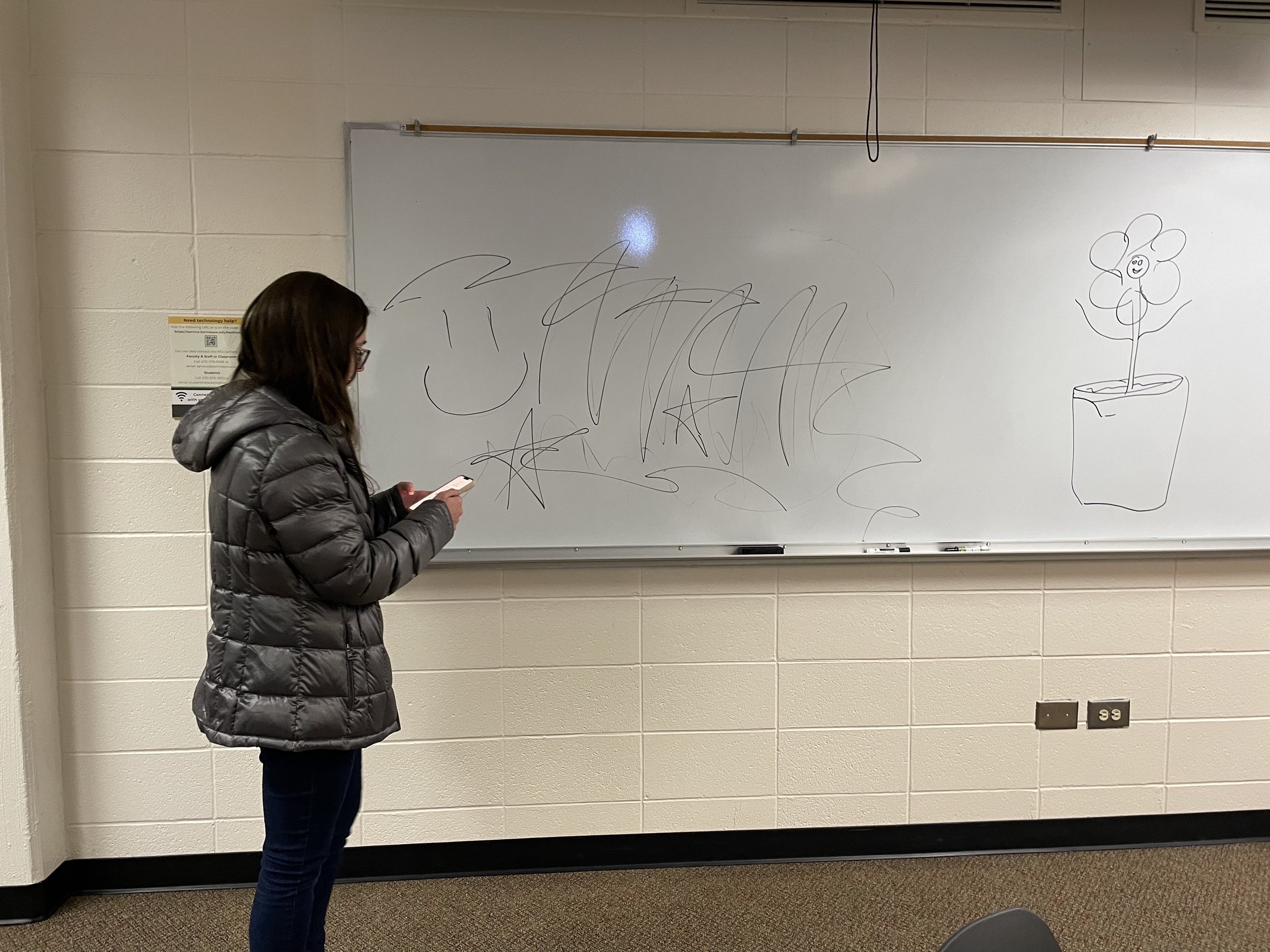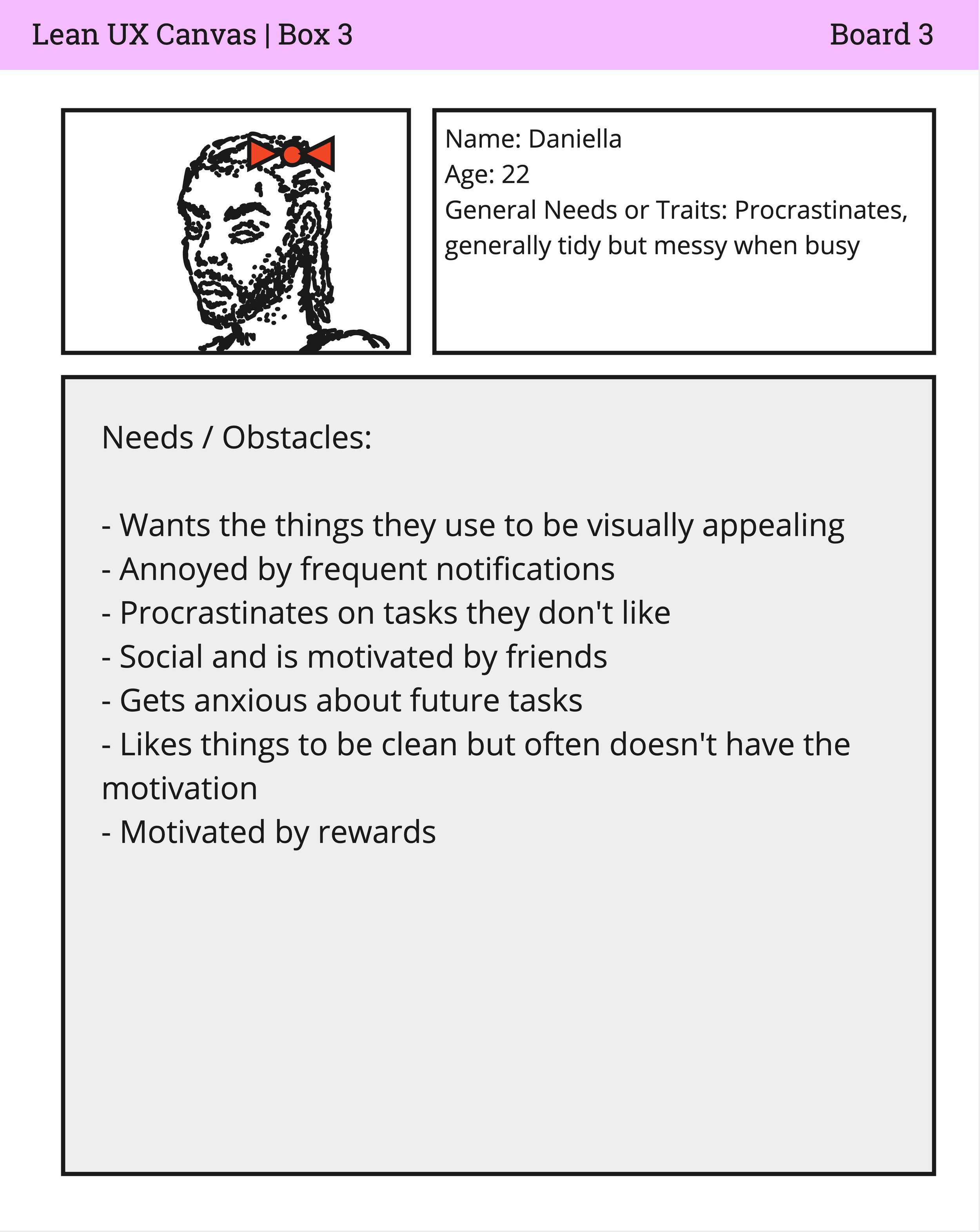Tidy Time
Motivating users to clean through the incorporation of gamification.
Created in Fall 2023 for the class Interaction Design II.
Introduction
Project Summary
Keeping a clean and organized living space can be a challenge for many individuals due to busy schedules, lack of motivation, or simply feeling overwhelmed by the task. The traditional approach of cleaning can often be mundane and uninspiring, leading to procrastination and a perpetually cluttered environment. Recognizing this, our app “Tidy Time” aims to enhance the cleaning experience through gamification.
My Role
As the team leader of a five-member group, I played an important role in every stage of our project. My responsibilities involved coordinating and facilitating interviews, conducting experiments, and crafting prototypes for our app through Figma. Additionally, I ensured the smooth progression of our tasks and made sure all checkpoints were complete in a timely order.
Team
JG
Justin Graham
Gahyun Kim
Sarah Pearson
John Grundorf
Matthew McNair
Product Problem Space
New Product Problem Statement
Our class began with individuals selecting and pitching a problem space rather than a specific app idea. I focused on the issue of people feeling unmotivated to clean. Once teams were formed, my team and I delved deeper into refining this problem space. The following details outline our decision.
The current state of cleaning apps has focused primarily on creating cleaning schedules for users. What existing products/services fail to address is motivating users to actually clean. Our product/service will address this gap by incorporating achievements and ranking systems. Our initial focus will be on college students. We'll know we are successful when we see more people marking the tasks as completed.
First Persona
We crafted a persona for our target app user; a man in his early 20’s. He wants to have a clean living space, but he lacks the energy or motivation to clean.
Although he maintains an active lifestyle, when it comes to cleaning, he is very lazy and is bad at time management. Some of this is because he is unsure how long tasks will take.
When he does attempt to clean, he finds himself frustrated that he lacks the tools and knowledge to successfully perform cleaning tasks.
Hypotheses
After considering our persona, we wrote the following hypotheses:
Users will be motivated to complete tasks through a timed checklist.
We will have increased usage of our app if users complete tasks through notifications that they have to take immediate action on.
We can keep the user coming back through a daily task.
More tasks will be completed continually if the user cleans more often through push notifications.
Users will be motivated to complete tasks through achievement badges.
Users will return to our app if they become organized through having a list of inputted tasks.
Hypothesis Prioritization
Due to limited time, we only had the opportunity to test a couple of these hypotheses. Because of this, we prioritized the ones we would test. We did this through assessing risk vs reward.
The first one we decided to test was #1 (Timed checklists). Our reasoning was that this feature could either motivate users to complete tasks, or it could cause them to get frustrated and delete the app.
The second hypothesis we wanted to test was #2 (Non-dismissible notifications). We found the idea of this feature exciting, as we couldn’t find a cleaning app that had incorporated this. However, we were unsure how users would react.
The third hypothesis we decided to test was a new hypotheses that we thought of after testing #2. The hypothesis states that users will feel more motivated to complete cleaning tasks via a leaderboard. This idea was an effective way to incorporate gamification, but it was risky because cleaning and competition aren’t commonly combined.
Sprint 1
Duration: 2 Weeks
Experiment 1
Hypothesis being tested:
Non-dismissible notifications will get users to complete more tasks than dismissible notifications.
For this experiment, we asked each user for two non-essential cleaning tasks that they could complete within the next two days. We informed them to let us know when or if they complete each task.
Experiment summary:
For the first day, we sent them a reminder to complete their task. They were allowed to ignore this reminder, just like they might with a regular notification.
Day 1
For the second day, just like with the first day, we sent them a reminder to complete their task. However, this task they could only perform immediately or reschedule. There was no option for them to ignore the reminder.
Day 2
We had overall mixed reactions to our notifications. We tested three users. Two of them stated that they disliked notifications and often ignored them. Two our of three of them also stated that they preferred the dismissible notification more. Because of this, we decided to pivot. For the next round of user tests, we decided to switch to focusing on gamification.
Findings
Experiment 2
Hypothesis being tested
A timer will motivate users to complete cleaning tasks.
For this experiment, we got users to complete cleaning tasks in our classroom. Prior to the experiment, we flipped chairs over, threw crumpled paper on the floor, and scribbled on the whiteboard. We then brought participants into the room and gave them our app, which listed that they had to put the chairs back at the desks, throw the paper away, and clean the whiteboard. Upon completing the tasks, users received stars. Afterwards, we interviewed them about their experience.
Experiment summary
Users overall seemed to have more fun with this experiment than the previous one. Two users liked the timer feature, the other was indifferent. All three users were confused by the stars. They didn’t understand if they were receiving them, or if the stars were ranking how well they did.
Findings
Sprint 2
Duration: 2 Weeks
Experiment 3
Hypothesis being tested
Users will feel more motivated to clean via our leaderboard.
For this experiment, we essentially repeated the prior experiment. However, this time in the app we displayed a leaderboard with made-up record times for the cleaning tasks. When they completed a task, the app told them they made a new record.
Experiment summary
The response to the addition of the leaderboard was very positive. All three users were motivated by it and enjoyed the competition. All users felt accomplished after completing the tasks. They also enjoyed the reward system.
Findings
Usability Test
For this week, we focused more on conducting a usability test rather than an experiment. We spent a lot of time developing our prototype. To lean more into gamification, we added a feature where users could earn in-game currency through completing cleaning tasks. They could use this currency to buy items for a virtual room.
We tested our app out with three users. We let them navigate throughout the app. When they expressed confusion, me made sure to ask them how they would expect the app to behave.
Summary
The main thing users noted throughout the testing was frustration over our app not being fully functional. This was actually a learning experience for my team. We realized that instead of having the whole app kind of ready, we should have focused on making one area completely functional. With our app not being at that state, we quickly realized that it left users overall confused.
We did get some helpful feedback about the room feature. They all liked it and found it motivating.
Findings
Solution
From the experiments we learned the following:
Many users found notifications annoying. Thus, our app should not be based around them.
Timers were effective in motivating users to complete cleaning tasks.
Leaderboards were also effective, and we also learned that many people are equally competitive with themselves.
Even more so than the leaderboard, users were motivated by rewards.
Cute visuals can bring joy to mundane tasks.
Overall learnings from experiments
Using the knowledge we had learned, we revised our persona to more accurately reflect our user research.
We decided to make our persona a woman. She is a generally tidy person, but her living environment can get messy when she is busy.
Overall, she wants the things she uses to be visually appealing. She gets stressed out easily when tasks start to stack up, and gets even more stressed when notifications remind her of the future tasks.
Motivation to clean is difficult for her, but she finds rewards and social pressure motivating.
Final Persona
Our solution was to create an app that allows you to input tasks, and add their difficulty level. The app also asks for an estimated time of completion. It displays this time on each task, and starts a timer when users begin the task. The app will remember how long it actually took users to complete each task, and will average this out to create a more accurate estimated time for that task in the future.
Based on the difficulty level of each task you complete, you receive in-game currency. This currency can be spent on furniture for a virtual room. Additionally, users can view other user’s decorated virtual rooms.
Final app idea
Reflection
During the project, I developed strong team leadership skills and learned to create effective user experiments. I also considerably improved at facilitating interviews and usability tests. Additionally, this project significantly contributed to my ability to recognize and reassess my assumptions. This experience provided me with a well-rounded skill set for successful project management and user-centered design.
What I learned
My team leaned heavily into experiments and research, but spent less time on ideation than some other teams. While I find gamification very interesting, I’d like to explore other ways of motivating users to clean. While users seemed excited about our app, I’d be curious to study how quickly they would lose interest. I think in order to get long term usage of our app, we’d have to figure out a way to keep the novelty.
Overall, I learned a significant amount through this project and will use those skills in my future work.











